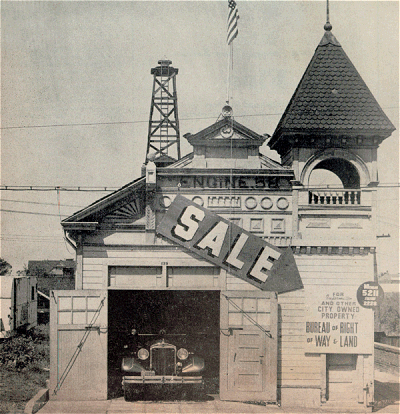|
58's
Passes Out of the Picture
After Fifty Years of Service,
the Oldest Engine House Goes Into the Discard, With For Sale Signs
Decorating Its From

THE
oldest remaining engine house in the city is doomed to become just a memory
in the very near future. The old structure up on Loma Drive is
plastered with big "For Sale" signs apropos to those of many a
fire sale it has seen come and go in its 50-year life. The lot was
purchased, the house built and put into service in 1892. The oldest
pictures of the house show its designation as Chemical Company No. 2, but as
early as 1900 it was known as Chemical No. 1, 137 South Belmont, near First
street. The records of 1900, when Fred Eaton was Mayor and Thomas
Strohm was Chief Engineer, show that W. H. Hoag, a Lieutenant, third class,
was in charge of the company, and G. W. Bright as a driver and Hiram Webb a
hoseman.
|
In the annual report of the city for the year 1903 it was
noted that the cost of the house was $2,000 and the value of the lot $700.
The present legal listing of the property (1946) shows the cost of the house
being $5,700 and the lot $875. These latter figures probably reflect the
cost of the brick kitchen and hose tower and other improvements that were added
about 1924. The equipment of the company in 1903 consisted of one Champion
Chemical Engine having two chemical tanks of 50 gallons capacity each drawn by a
team of two horses. In that year G. W. Bright had become the Lieutenant in
charge and Charles Elgin was the driver and H. A. Brown the hoseman. In 1903 the figures on the operation of the department
present an interesting comparison with the present day. In Chemical
2's heyday the Los Angeles Fire Department responded to 571 alarms of which
502 were actual fires and 69 were false alarms. There were eight
second alarms and the total fire loss for the city that year was
$180,173. The four chemical companies in service used a total of
12,193 gallons of chemicals in that year. There were 12 engine
companies, three ladder companies, five hose companies and the four
chemicals. There were 128 men, including the Chief Engineer, and 82
horses on the payroll. The cost of operating the house in those days
ran as follows:
Salaries
Barley and bran
Horse shoeing
Apparatus repair
Harness repair
Hardware and tools
Lumber
Coal oil
Acid and soda
Drugs and medicines
Light
Plumbing
Total operating expense
Chemical No. 1 for year 1903 |
$2771.10
25.56
30.00
27.00
3.70
10.00
9.30
6.98
53.63
4.50
11.45
146.19
.
.
53099.41 |
Somewhere between that year and 1914 Chemical 1 became Hose 4 and then in
1924 it received a triple combination apparatus and became Engine Company
No. 58. Deputy Chief Rothermel was a Lieutenant at 6s in those days
when 58s moved over with 6s while their house was being overhauled and the
kitchen and tower built. The list of men who have worked at this old
station would make an impressive legion if there were sufficient records to
compile them.
But
the end of the trail is near and the Bureau of Right of Way and Land has 58s
up for sale to the highest bidder, all bids to start at a minimum of
$3,300. 58s will move to 6s for the time being, at least, and from
there probably to a new location some day in the future.
|